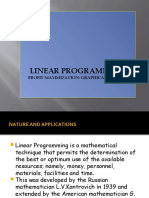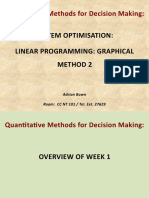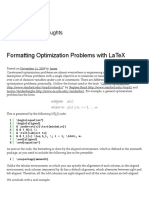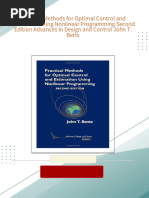Linear Programming Problem
Uploaded by
aneesaasad91Linear Programming Problem
Uploaded by
aneesaasad91Linear Programming Problem Statement
Problem 1:A furniture company manufactures two types of products:
Product X and Product Y. The production of these products is limited by
the availability of wood and labor hours. The given constraints and profit
information are as follows:
Resource Constraints:
1. Wood Usage Constraint:
o Each unit of Product X requires 2 units of wood.
o Each unit of Product Y requires 1 unit of wood.
o The total available wood is 100 units.
2. Labor Usage Constraint:
o Each unit of Product X requires 1 hour of labor.
o Each unit of Product Y requires 2 hours of labor.
o The total available labor hours are 80.
3. Non-Negativity Constraints:
o The number of units of Product X and Product Y cannot be
negative:
o Y≥0
o X≥0
Objective Function (Profit Maximization):
The company earns a profit of ₹500 per unit of Product X and ₹400 per
unit of Product Y. The goal is to maximize total profit:
Task:
1. Graphically identify the feasible region using the given
constraints.
2. Find the corner points of the feasible region.
3. Calculate the total profit at each corner point.
4. Determine the optimal number of units of Product X and
Product Y to maximize profit.
Use both graphical and mathematical methods to find the maximum
profit and optimal production quantities.
Let's solve this Linear Programming Problem (LPP) step by step.
Step 1: Define Variables
Let:
X = Number of units of Product X
Y= Number of units of Product Y
Step 2: Formulate the Constraints
1. Wood Constraint:
Each unit of Product X requires 2 units of wood, and each unit of Product
Y requires 1 unit of wood.
Total available wood = 100 units
2X+Y=100
2. Labor Constraint:
Each unit of Product X requires 1 labor hour, and each unit of Product Y
requires 2 labor hours.
Total available labor = 80 hours
3. Non-Negativity Constraints:
X≥0, Y≥0
Step 3: Objective Function (Profit Maximization)
The profit is given as:
₹500 per unit of Product X
₹400 per unit of Product Y
The objective is to maximize profit:
Z=500X+400Y
Step 4: Find the Feasible Region
To plot the constraints graphically, we convert inequalities into equalities
and find intercepts.
Equation 1: 2X+Y=100
X-intercept (Set Y=0)
2X=100
X=50 So, point (50,0).
Y-intercept (Set X=0)
Y=100 , point (0,100).
Equation 2: X+2Y=80
X-intercept (Set Y=0):
X=80
So, point (80,0).
Y-intercept (Set X=0):
2Y = 80
Y = 40
So, point (0,40).
Step 5: Find the Corner Points
The feasible region is the common shaded area satisfying both
inequalities.
Corner points:
1. Intersection of 2X+Y=100
2. and X+2Y=80
Solve simultaneously:
o Multiply X+2Y=80
o 2X+4Y=160
o Subtract equation 2X+Y=100
o 2X+4Y=160-(2X+Y=100)
o So, intersection point = (40,20).
Thus, the corner points are:
1. (0,40)
2. (40,20)
3. (50,0)
Step 6: Compute Profit at Each Corner Point
Using Z=500X+400Y
Corner Z=500X+400Y Profit
Point Z=500X+400Y (₹)
500(0)+400(40)
(0,40) ₹16,000
500(0)+400(40)
500(40)+400(20)
(40,20) ₹28,000
500(40)+400(20)
500(50)+400(0)
(50,0) ₹25,000
500(50)+400(0)
Step 7: Identify the Optimal Solution
Maximum profit is ₹28,000 at (40,20).
So, the company should produce 40 units of Product X and 20 units
of Product Y for maximum profit.
Final Answer
Optimal Production Plan:
Product X = 40 units
Product Y = 20 units
Maximum Profit = ₹28,000
Problem 2: Production Optimization
A carpentry shop makes two types of tables: Deluxe (X) and Standard
(Y). The production is limited by available wood and labor hours.
Constraints:
1. A Deluxe table requires 3 units of wood and 2 hours of labor.
2. A Standard table requires 2 units of wood and 1 hour of labor.
3. The company has 120 units of wood and 80 labor hours available.
4. Non-negativity: X≥0 Y≥0.
Objective Function (Maximize Profit):
Profit per Deluxe table = ₹600
Profit per Standard table = ₹400
Maximize: Z=600X+400Y
Find the feasible region, corner points, and the optimal production
for maximum profit.
Problem 3: Bakery Production
A bakery produces Cakes (X) and Pastries (Y). The availability of flour and
baking time limits production.
Constraints:
1. Each Cake requires 4 kg of flour and 2 hours of baking.
2. Each Pastry requires 2 kg of flour and 1 hour of baking.
3. The bakery has 100 kg of flour and 50 baking hours available.
4. Non-negativity: X≥0 Y≥0.
Objective Function (Maximize Profit):
Profit per Cake = ₹800
Profit per Pastry = ₹500
Maximize: Z=800X+500Y
Determine the best combination of Cakes and Pastries to
maximize profit.
Problem 4: Electronics Manufacturing
A factory produces Laptops (X) and Tablets (Y). The production is limited
by chip availability and assembly hours.
Constraints:
1. A Laptop requires 5 chips and 3 hours of assembly.
2. A Tablet requires 3 chips and 2 hours of assembly.
3. The factory has 150 chips and 90 assembly hours available.
4. Non-negativity: X≥0 Y≥0.
Objective Function (Maximize Profit):
Profit per Laptop = ₹10,000
Profit per Tablet = ₹7,000
Maximize: Z=10,000X+7,000Y
Find the feasible region, identify the best production mix, and
compute maximum profit.
Problem 5: Garment Production
A clothing factory produces Shirts (X) and Trousers (Y). The production is
limited by fabric availability and sewing hours.
Constraints:
1. A Shirt requires 2 meters of fabric and 3 hours of sewing.
2. A Trouser requires 3 meters of fabric and 2 hours of sewing.
3. The factory has 180 meters of fabric and 120 sewing hours
available.
4. Non-negativity: X≥0 Y≥0.
Objective Function (Maximize Profit):
Profit per Shirt = ₹700
Profit per Trouser = ₹900
Maximize: Z=700X+900Y
Find the optimal production plan for maximum profit.
Problem 6: Agriculture Planning
A farmer grows Wheat (X) and Corn (Y). The land and labor available are
limited.
Constraints:
1. Each hectare of Wheat requires 5 labor hours and 3 tons of
fertilizer.
2. Each hectare of Corn requires 4 labor hours and 2 tons of fertilizer.
3. The farmer has 200 labor hours and 150 tons of fertilizer
available.
4. Non-negativity: X≥0 Y≥0.
Objective Function (Maximize Revenue):
Revenue per hectare of Wheat = ₹4,000
Revenue per hectare of Corn = ₹3,500
Maximize: Z=4,000X+3,500Y
Determine the best crop allocation to maximize revenue.
Problem 7: Chemical Production
A company manufactures Chemical A (X) and Chemical B (Y). The
production is limited by raw material supply and processing time.
Constraints:
1. Each unit of Chemical A requires 3 kg of raw materials and 4 hours
of processing.
2. Each unit of Chemical B requires 2 kg of raw materials and 3 hours
of processing.
3. The company has 240 kg of raw materials and 300 processing
hours available.
4. Non-negativity: X≥0 Y≥0.
Objective Function (Maximize Profit):
Profit per unit of Chemical A = ₹1,200
Profit per unit of Chemical B = ₹900
Maximize: Z=1,200X+900Y
Find the feasible region and calculate the optimal production
for maximum profit.
Problem 8: Transportation Cost Minimization
A logistics company transports Product X and Product Y between cities.
The cost depends on fuel consumption and driver hours.
Constraints:
1. Each unit of Product X requires 3 liters of fuel and 5 driver hours.
2. Each unit of Product Y requires 2 liters of fuel and 4 driver hours.
3. The company has 500 liters of fuel and 800 driver hours available.
4. Non-negativity: X≥0 Y≥0.
Objective Function (Minimize Cost):
Cost per unit of Product X = ₹1,000
Cost per unit of Product Y = ₹800
Minimize: Z=1,000X+800Y
Determine the optimal number of products to be transported
to minimize cost.
Problem 9: Factory Output Planning
A factory produces Mobile Phones (X) and Tablets (Y), subject to material
and labor constraints.
Constraints:
1. Each Mobile Phone requires 4 units of material and 2 hours of
labor.
2. Each Tablet requires 3 units of material and 3 hours of labor.
3. The factory has 300 units of material and 240 labor hours
available.
4. Non-negativity: X≥0 Y≥0.
Objective Function (Maximize Profit):
Profit per Mobile Phone = ₹5,000
Profit per Tablet = ₹6,000
Maximize: Z=5,000X+6,000Y
Find the best production mix for maximum profit.
Problem 10: Dairy Production
A dairy farm produces Milk (X) and Cheese (Y). The production is limited
by cattle feed and processing capacity.
Constraints:
1. Each liter of Milk requires 1 kg of cattle feed and 2 processing
hours.
2. Each kg of Cheese requires 2 kg of cattle feed and 3 processing
hours.
3. The farm has 500 kg of cattle feed and 600 processing hours
available.
4. Non-negativity: X≥0 Y≥0
Objective Function (Maximize Profit):
Profit per liter of Milk = ₹100
Profit per kg of Cheese = ₹200
Maximize: Z=100X+200Y
Determine the optimal quantity of Milk and Cheese for
maximum profit.
roblem 11: Fast Food Restaurant Optimization
A fast-food restaurant sells Burgers (X) and Fries (Y). The production is
limited by meat availability and cooking time.
Constraints:
1. A Burger requires 2 kg of meat and 5 minutes of cooking time.
2. Fries require 1 kg of meat and 3 minutes of cooking time.
3. The restaurant has 200 kg of meat and 500 minutes of cooking
time available.
4. Non-negativity: X≥0X \geq 0X≥0, Y≥0Y \geq 0Y≥0.
Objective Function (Maximize Revenue):
Revenue per Burger = ₹250
Revenue per Fries = ₹150
Maximize: Z=250X+150YZ = 250X + 150YZ=250X+150Y.
Find the best combination of Burgers and Fries to maximize
revenue.
How to Solve?
For each problem:
1. Write the constraints as equations/inequalities.
2. Plot them on a graph (if required).
3. Find the feasible region and corner points.
4. Evaluate the objective function at each corner point.
5. Find the optimal solution (maximum or minimum value).
You might also like
- Chapter 2 Productivity Problems With Sample Solutions Problem 1100% (9)Chapter 2 Productivity Problems With Sample Solutions Problem 15 pages
- ATI TEAS Calculation Workbook: 300 Questions to Prepare for the TEAS (2024 Edition)From EverandATI TEAS Calculation Workbook: 300 Questions to Prepare for the TEAS (2024 Edition)No ratings yet
- Problem 1: Figure 1: The Ensaymada Made by Linda's Bakery Figure 2: The Egg Tarts Linda's Bakery ProduceNo ratings yetProblem 1: Figure 1: The Ensaymada Made by Linda's Bakery Figure 2: The Egg Tarts Linda's Bakery Produce9 pages
- Choose The Unknowns. X Type A Trucks y Type B Trucks Write The F (X, Y) 30x + 40y100% (1)Choose The Unknowns. X Type A Trucks y Type B Trucks Write The F (X, Y) 30x + 40y5 pages
- Midterms Reviewer - No Northwest Corner Least Cost Method Vogels MethodNo ratings yetMidterms Reviewer - No Northwest Corner Least Cost Method Vogels Method24 pages
- Decision Variables:: Linear Programming ModelNo ratings yetDecision Variables:: Linear Programming Model3 pages
- Operations Research: Text Book: Operations Research: An Introduction by Hamdy A.Taha (Pearson Education) 8 EditionNo ratings yetOperations Research: Text Book: Operations Research: An Introduction by Hamdy A.Taha (Pearson Education) 8 Edition34 pages
- Formulation of Linear Programming Model - UpdatedNo ratings yetFormulation of Linear Programming Model - Updated13 pages
- Institute of Business Administration, Karachi: EMBA Program100% (1)Institute of Business Administration, Karachi: EMBA Program6 pages
- Topic 6 - Linear Programming - Graphical Method 2No ratings yetTopic 6 - Linear Programming - Graphical Method 252 pages
- Visual Financial Accounting for You: Greatly Modified Chess Positions as Financial and Accounting ConceptsFrom EverandVisual Financial Accounting for You: Greatly Modified Chess Positions as Financial and Accounting ConceptsNo ratings yet
- GCSE Mathematics Numerical Crosswords Higher Tier Written for the GCSE 9-1 CourseFrom EverandGCSE Mathematics Numerical Crosswords Higher Tier Written for the GCSE 9-1 CourseNo ratings yet
- Full download International Scientific Conference Energy Management of Municipal Facilities and Sustainable Energy Technologies EMMFT 2019: Volume 1 Vera Murgul pdf docx100% (4)Full download International Scientific Conference Energy Management of Municipal Facilities and Sustainable Energy Technologies EMMFT 2019: Volume 1 Vera Murgul pdf docx55 pages
- The Optimization of Injection Molding Processes Using DOENo ratings yetThe Optimization of Injection Molding Processes Using DOE8 pages
- Physics-Based Learning Models For Ship HydrodynamicsNo ratings yetPhysics-Based Learning Models For Ship Hydrodynamics22 pages
- Analysis and Optimization of The Transmission Angle of Crank Rocker MechanismNo ratings yetAnalysis and Optimization of The Transmission Angle of Crank Rocker Mechanism4 pages
- Facilities Location Optimization for Supply Chain Cost MinimizationNo ratings yetFacilities Location Optimization for Supply Chain Cost Minimization5 pages
- EC004 OutputDynamics - Microfoundation 2022 Lecture3No ratings yetEC004 OutputDynamics - Microfoundation 2022 Lecture315 pages
- Review of Aerofoil Parameterisation Methods For Aerodynamic Shape OptimisationNo ratings yetReview of Aerofoil Parameterisation Methods For Aerodynamic Shape Optimisation20 pages
- 2012 10 Hansa Overcoming The Challenges in Vessel Speed OptNo ratings yet2012 10 Hansa Overcoming The Challenges in Vessel Speed Opt5 pages
- Systematic Review On Model Predictive Control Strategies Applied To Active Thermal Energy Storage SystemsNo ratings yetSystematic Review On Model Predictive Control Strategies Applied To Active Thermal Energy Storage Systems14 pages
- Formatting Optimization Problems With LaTeX - JC NotesNo ratings yetFormatting Optimization Problems With LaTeX - JC Notes5 pages
- Practical Methods for Optimal Control and Estimation Using Nonlinear Programming Second Edition Advances in Design and Control John T. Betts All Chapters Instant Download100% (4)Practical Methods for Optimal Control and Estimation Using Nonlinear Programming Second Edition Advances in Design and Control John T. Betts All Chapters Instant Download61 pages
- 009-001 - Chief (Technical Assurance & Capability) - Do & DeliverNo ratings yet009-001 - Chief (Technical Assurance & Capability) - Do & Deliver1 page
- Towards A Reinforcement Learning Environment Toolbox For Intelligent Electric Motor ControlNo ratings yetTowards A Reinforcement Learning Environment Toolbox For Intelligent Electric Motor Control8 pages
- (Ebook PDF) Optimization in Operations Research 2nd Edition 2024 Scribd Download100% (4)(Ebook PDF) Optimization in Operations Research 2nd Edition 2024 Scribd Download51 pages
- Chapter 2 Productivity Problems With Sample Solutions Problem 1Chapter 2 Productivity Problems With Sample Solutions Problem 1
- ATI TEAS Calculation Workbook: 300 Questions to Prepare for the TEAS (2024 Edition)From EverandATI TEAS Calculation Workbook: 300 Questions to Prepare for the TEAS (2024 Edition)
- Problem 1: Figure 1: The Ensaymada Made by Linda's Bakery Figure 2: The Egg Tarts Linda's Bakery ProduceProblem 1: Figure 1: The Ensaymada Made by Linda's Bakery Figure 2: The Egg Tarts Linda's Bakery Produce
- Choose The Unknowns. X Type A Trucks y Type B Trucks Write The F (X, Y) 30x + 40yChoose The Unknowns. X Type A Trucks y Type B Trucks Write The F (X, Y) 30x + 40y
- Midterms Reviewer - No Northwest Corner Least Cost Method Vogels MethodMidterms Reviewer - No Northwest Corner Least Cost Method Vogels Method
- Operations Research: Text Book: Operations Research: An Introduction by Hamdy A.Taha (Pearson Education) 8 EditionOperations Research: Text Book: Operations Research: An Introduction by Hamdy A.Taha (Pearson Education) 8 Edition
- Institute of Business Administration, Karachi: EMBA ProgramInstitute of Business Administration, Karachi: EMBA Program
- Visual Financial Accounting for You: Greatly Modified Chess Positions as Financial and Accounting ConceptsFrom EverandVisual Financial Accounting for You: Greatly Modified Chess Positions as Financial and Accounting Concepts
- Practice Problems in Statistics and Data ReductionFrom EverandPractice Problems in Statistics and Data Reduction
- GCSE Mathematics Numerical Crosswords Higher Tier Written for the GCSE 9-1 CourseFrom EverandGCSE Mathematics Numerical Crosswords Higher Tier Written for the GCSE 9-1 Course
- Mind Sharpener - Easy Math for Hard Life ProblemsFrom EverandMind Sharpener - Easy Math for Hard Life Problems
- Full download International Scientific Conference Energy Management of Municipal Facilities and Sustainable Energy Technologies EMMFT 2019: Volume 1 Vera Murgul pdf docxFull download International Scientific Conference Energy Management of Municipal Facilities and Sustainable Energy Technologies EMMFT 2019: Volume 1 Vera Murgul pdf docx
- The Optimization of Injection Molding Processes Using DOEThe Optimization of Injection Molding Processes Using DOE
- Physics-Based Learning Models For Ship HydrodynamicsPhysics-Based Learning Models For Ship Hydrodynamics
- Analysis and Optimization of The Transmission Angle of Crank Rocker MechanismAnalysis and Optimization of The Transmission Angle of Crank Rocker Mechanism
- Facilities Location Optimization for Supply Chain Cost MinimizationFacilities Location Optimization for Supply Chain Cost Minimization
- EC004 OutputDynamics - Microfoundation 2022 Lecture3EC004 OutputDynamics - Microfoundation 2022 Lecture3
- Review of Aerofoil Parameterisation Methods For Aerodynamic Shape OptimisationReview of Aerofoil Parameterisation Methods For Aerodynamic Shape Optimisation
- 2012 10 Hansa Overcoming The Challenges in Vessel Speed Opt2012 10 Hansa Overcoming The Challenges in Vessel Speed Opt
- Systematic Review On Model Predictive Control Strategies Applied To Active Thermal Energy Storage SystemsSystematic Review On Model Predictive Control Strategies Applied To Active Thermal Energy Storage Systems
- Formatting Optimization Problems With LaTeX - JC NotesFormatting Optimization Problems With LaTeX - JC Notes
- Practical Methods for Optimal Control and Estimation Using Nonlinear Programming Second Edition Advances in Design and Control John T. Betts All Chapters Instant DownloadPractical Methods for Optimal Control and Estimation Using Nonlinear Programming Second Edition Advances in Design and Control John T. Betts All Chapters Instant Download
- 009-001 - Chief (Technical Assurance & Capability) - Do & Deliver009-001 - Chief (Technical Assurance & Capability) - Do & Deliver
- Towards A Reinforcement Learning Environment Toolbox For Intelligent Electric Motor ControlTowards A Reinforcement Learning Environment Toolbox For Intelligent Electric Motor Control
- (Ebook PDF) Optimization in Operations Research 2nd Edition 2024 Scribd Download(Ebook PDF) Optimization in Operations Research 2nd Edition 2024 Scribd Download
























































































